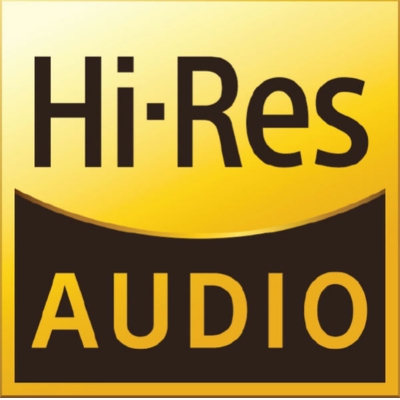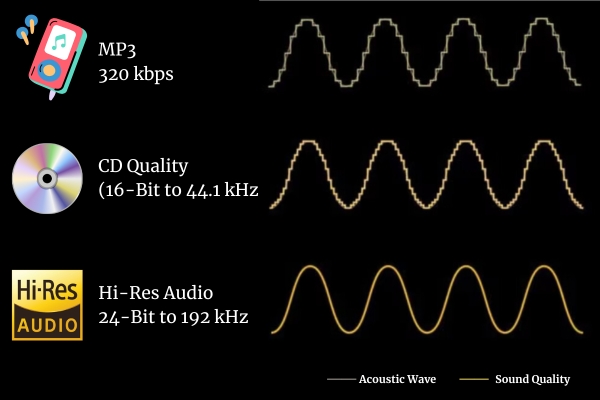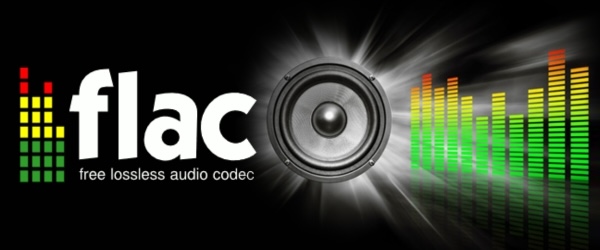Hi-Res Audio Explained: What It Is and Why It Matters
If you’re in the market for a new sound system, amplifier, or TV, you’ve probably seen the term “Hi-Res Audio compatible” or a badge indicating support for high-resolution sound. But what does that actually mean?
For anyone who isn’t an audio engineer, Hi-Res Audio might sound like just another marketing gimmick, but there’s actually real substance behind it, and it can make a huge difference in sound quality. In this article, we’ll break down what Hi-Res Audio is, why it matters, and how you can experience it for yourself.
What is Hi-Res Audio?

At its core, Hi-Res Audio (High-Resolution Audio) is about better sound quality. It delivers more detail, depth, and clarity than traditional digital formats like CDs or MP3s.
With a higher sampling rate and bit depth, Hi-Res Audio captures more of the original recording’s nuances, preserving subtle details that often get lost in compressed formats.
This results in richer textures, more accurate instrument separation, and a more immersive listening experience. To understand this, let’s quickly go over how digital audio works:
- Digital audio is made up of tiny “snapshots” of sound, taken thousands of times per second. These are called samples.
- The more samples per second (sample rate) and the more detailed each sample is (bit depth), the higher the sound quality.
How Does Hi-Res Audio Compare?
| Audio Format | Bit Depth | Sample Rate | Sound Quality |
|---|---|---|---|
| MP3 (lossy) | 16-bit | 44.1 kHz | Compressed, lower quality |
| CD Quality | 16-bit | 44.1 kHz | Standard digital quality |
| Hi-Res Audio | 24-bit | 96 kHz+ | More detail, closer to the original recording |
In a nutshell, Hi-Res Audio captures more detail, nuance, and realism, making it sound closer to what the artist originally intended.
Lossy vs. Lossless Audio: Why It Matters
When digital music is stored, it can be saved in two main ways Lossy and Lossless formats:
Lossy Formats (MP3, AAC) → Smaller Files, Lower Quality
- MP3s are compressed audio files.
- They remove subtle details to shrink the file size.
- While convenient, they sacrifice clarity, depth, and instrument separation.
Lossless Formats (FLAC, WAV, ALAC) → Full Detail, No Quality Loss
- Lossless files preserve every detail of the original recording.
- They sound more natural, crisp, and immersive.
- Modern storage and streaming speeds mean there’s no longer a need to compromise on quality.
This is why many audiophiles and music lovers are shifting to lossless streaming services like TIDAL, Apple Music Lossless, and Amazon Music HD, which offer Hi-Res Audio tracks.
The Role of DACs (Digital-to-Analog Converters)
What is a DAC?
Every digital device—whether it’s a smartphone, laptop, or CD player—has a built-in Digital-to-Analog Converter (DAC). Its job is to turn digital code (1s and 0s) into actual sound waves that you can hear.
However, the built-in DACs in most devices are not designed for high performance. They are often included as cheaply as possible, which can result in flat, dull sound.
Why Upgrade to a High-Quality DAC?
A dedicated DAC is like an HDTV for your ears—it improves clarity, expands the soundstage, and brings out hidden details in your favorite tracks.
If you listen to Hi-Res Audio, whether streaming or from a local file, an external DAC can dramatically improve your listening experience. Popular Hi-Res DACs include the AudioQuest DragonFly, iFi Zen DAC, and Schiit Modi+.
How to Experience Hi-Res Audio
Now that you understand what Hi-Res Audio is, the next step is experiencing it for yourself. Achieving high-resolution sound requires three key components: a source (music files or streaming), a capable player (software or hardware), and quality output (DACs, headphones, or speakers). Here’s how to optimize each step:
Choose a Hi-Res Audio Source
The first step is getting access to Hi-Res music files. Standard MP3s or even CD-quality audio won’t cut it. You need files or streams that offer 24-bit/96kHz quality or better.
There are two main ways to get Hi-Res music:
- Hi-Res Streaming Services – Platforms like TIDAL HiFi Plus, Qobuz, Apple Music Lossless, and Amazon Music HD offer millions of tracks in high-resolution formats.
- Downloadable Hi-Res Files – If you prefer owning your music, sites like HDtracks, ProStudioMasters, and Qobuz sell FLAC, WAV, and DSD files that maintain every detail of the original studio recording.
Streaming is the easiest way to experience Hi-Res Audio, but downloads provide better control over quality since streaming can sometimes be affected by network conditions. Many streaming services offer vast Hi-Res libraries, making it convenient to access high-fidelity music instantly.
That said, downloading Hi-Res files from platforms like HDtracks and ProStudioMasters ensures that you get the full, uncompressed quality without any risk of buffering, compression artifacts, or service limitations.

Use a Hi-Res Audio Player
Playing Hi-Res Audio requires compatible software or hardware that can handle higher sample rates and bit depths.
Software Players (Desktop & Mobile)
If you listen on a computer or smartphone, you’ll need a Hi-Res-compatible music player, such as
- VLC Media Player, Audirvana, Roon (for PC/Mac)
- USB Audio Player Pro, Neutron Music Player (for Android/iOS)
These players bypass internal software limitations, ensuring that your Hi-Res files play at full quality. Unlike standard media players, they support bit-perfect playback, meaning the audio signal remains untouched, preserving every detail from the original recording.
Many of these apps also offer advanced features like ASIO and WASAPI support, which help reduce latency and improve sound clarity, making them ideal for audiophiles and serious listeners.
Dedicated Hi-Res Audio Players
For the best portable experience, a dedicated Hi-Res music player is best. Unlike smartphones, these are built to deliver superior sound without interference from other apps or processes.
Two great options are:
- Sony NW-A105 – Compact, affordable, and supports major Hi-Res formats.
- FiiO M11Plus – Premium digital audio player with balanced sound and high-resolution support.
A dedicated player is a game-changer if you’re serious about high-quality portable audio. Unlike smartphones, which prioritize convenience over sound fidelity, these devices are designed specifically for Hi-Res playback. They have superior DACs, powerful headphone amplifiers, and support for high-bitrate formats like DSD and FLAC.

Upgrade Your DAC for Better Sound
Even if you have Hi-Res music and a compatible player, you might not be hearing its full potential. That’s because most built-in DACs (Digital-to-Analog Converters) are low-quality and limit audio performance.
A high-quality external DAC dramatically improves sound by accurately converting digital files into richer, more natural analog audio.
Types of DACs:
- Portable DACs (for phones & laptops): Compact and powerful, these override the weak DAC inside your device. Examples:
- AudioQuest DragonFly Cobalt – USB-powered, great for laptops and mobile use.
- iFi Hip DAC 2 – Stylish, portable, and powerful.
- Desktop DACs (for home setups): These provide even higher fidelity and often include a built-in headphone amplifier.
- Fosi Audio ZD3 – Compact Hi-Fi amplifier with powerful, clean sound.
- Chord Mojo 2 – Audiophile-grade with outstanding detail.
If you listen to Hi-Res music regularly, a DAC upgrade can be one of the most noticeable improvements to your sound quality.
While most smartphones, laptops, and even some audio devices include built-in DACs, these are often low-quality, cost-efficient components that prioritize basic functionality over high-fidelity playback. An external DAC bypasses these limitations, delivering a clearer, more dynamic sound with greater depth and detail.
Choose the Right Headphones & Speakers
Your listening gear matters as much as the source and DAC. Even the best Hi-Res file won’t sound great if your headphones or speakers can’t accurately reproduce the extra detail.
For Personal Listening:
A great pair of Hi-Res-certified headphones allows you to fully appreciate the depth and clarity of high-resolution tracks. Some top choices include:
- Sennheiser HD 600 – Classic open-back headphones with natural, detailed sound.
- V-Moda Crossfade M-100 Master – Hi-Res headphones with powerful bass and durable build.
For Home Audio:
If you prefer listening through speakers, look for Hi-Res-certified sound systems that support lossless playback. Some great options include:
- Bluesound NODE – A Hi-Res streaming music player that integrates with your home setup.
- WiiM Amp – Versatile streaming amplifier with Hi-Res audio and multi-room support.
A good audio setup reveals details you never noticed before, making music sound more immersive and lifelike. Even with Hi-Res music and a high-quality DAC, your listening experience will only be as good as the headphones or speakers delivering the sound.
Whichever way you like listening to your music, investing in quality audio gear ensures that you experience Hi-Res music as it was meant to be heard: rich, dynamic, and incredibly detailed.
Is Hi-Res Audio Worth It?
For those who appreciate realistic, detailed, and immersive sound, Hi-Res Audio is undeniably worth it. You get a level of clarity that allows you to hear the subtle textures of instruments, vocal nuances, and the spatial depth of any recording.
What makes Hi-Res Audio even more compelling is its accessibility. With the rise of high-quality streaming services, affordable DACs, and Hi-Res-certified headphones and speakers, you can experience studio-quality sound everywhere you go.
Check out more from our Soundrating Blog…
How to Create the Best Home Audio Experience
Surround Sound Setup: Best Speaker Placement for Immersive Audio

I am a passionate and skilled car audio enthusiast with 15 years of experience in the industry. My journey started when I replaced my first set of factory car speakers, sparking a deep love for high-quality sound. Since then, I have worked as a representative for renowned brands like Kenwood and Alpine.
With a background in both retail and distribution, I have developed a comprehensive understanding of the car audio market. Currently a certified (MECP) installer in the Mobile Electronics industry, my expertise lies in delivering top-notch audio installations. My knowledge, coupled with my genuine passion, makes me the go-to professional for all car audio needs.

